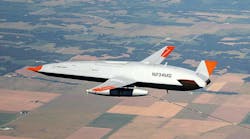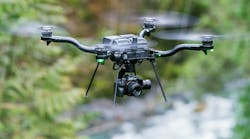WASHINGTON — As combat operations in Iraq grind on, so does the evolution of the post–Cold War defense strategy from deterring nuclear war to preempting actual and potential terrorists.
The defense budget projections over the next decade from the Arlington, Va.–based Government Electronics and Information Technology Association (GEIA), reflect this transformation. The projections were unveiled in October at the GEIA's annual 10-year forecast conference in Washington, D.C.
Heartening news for the electronics industry revolves around the anticipated rise in the electronics share of the U.S. Department of Defense (DOD) budget through 2014. During this period, electronics spending should increase from $76.94 billion in fiscal year 2004, which began on Oct. 1, to $92.1 billion in 2014. All numbers are in budget authority rather than actual expenditures and are in constant 2004 dollars.
GEIA further breaks down these electronics-content figures into three major categories: procurement is to rise from $29.77 billion to $35.71 billion over the period; research, development, test, and evaluation, or RDT&E, is to rise from $34.54 billion to $35.03 billion; and operations and maintenance, or O&M, is to rise from $12.63 billion to $21.37 billion.
Of particular significance are those O&M numbers. DOD suppliers would be well advised to adjust their strategies to take advantage of this trend. The GEIA projection shows what anybody with any substantial experience in the defense industry intuitively knows: when the bullets start flying the investment accounts of procurement and RDT&E are likely to be the first to suffer.
The military personnel, or MILPERS, category is due to take a major share of the DOD's budget authority over the next decade, from $98.96 billion in 2004 to $99.53 billion in 2014. Over the same period total O&M is due to rise from $117.2 billion to $137.24 billion. Both of these categories have been rising faster than inflation, according to GEIA estimates, and threaten to crowd out the projected investment increases if they are not controlled. Health-care costs alone have been rising at 6 percent a year lately, and GEIA expressed concern that they may grow even faster.
In fairness to DOD planners, this transformation began after the 1989-91 meltdown of the Soviet Union. The Sept. 11 terrorist attack and the military operations in Afghanistan and Iraq have merely accelerated the process. The GEIA analysis puts it this way: "Our nation is fighting a new type of war, the war on terrorism. Deterrence as a policy has given way to preemption, which portends greater engagement throughout the world."
Presenting the GEIA analysis was James Wrightson, chairman of the organization's forecast committee and vice president for strategic planning at Lockheed Martin Corp. in Bethesda, Md.
Another way to look at the changed environment, and one that was also prevalent during the Cold War, is to consider the aspect of asymmetry. The Cold War was asymmetrical because it pitted the overwhelming masses of Soviet and other Warsaw Pact troops against the more sophisticated U.S. and NATO weaponry, which relied heavily on electronics as a force multiplier. Now the tables may be turned. For example, the recent attacks on UH-60 Black Hawk and CH-47 Chinook helicopters by shoulder-fired surface-to-air missiles (Sims) raise questions about the superiority of U.S. weapons in this environment.
These weapons were originally supplied by the United States to the rebels in Afghanistan to repel a Soviet invasion, and about 5,000 are reportedly in existence in the Middle East. However, only about a third of them have been accounted for. I don't think it's too far-fetched to liken the role of those Sims in the current preemption environment to the role of the Colt .45 revolver in the settling of the American West. The Colt .45 made the small man as formidable as the big man, and Sims may do the same today.
Moreover, the focus on commercial off-the-shelf (COTS) technology to reduce costs, as instituted by the previous administration, increases the worldwide availability of military technologies.
While Defense Secretary Donald Rumsfeld has been vocal about his all-out transformation push, including downsizing the forces and pulling decision-making up the chain of command to the Office of the Secretary of Defense (OSD), much of this transformation logically follows the evolution of supporting technologies. High on his — and EIA's — list is network-centric warfare, which the organization calls "an incredible force multiplier [that] will also create new opportunities for industry, even as it threatens some traditional systems." Also on the transformation list are unmanned air vehicles (UAVs) and unmanned combat air vehicles (UCAVs), which GEIA says will receive 30 percent more money in 2004 than 2003; space-based radar; the Navy's littoral combat ship program; and the Army's Future Combat System (FCS).
The downsizing, by the way, envisions reducing overall troop strength by 64,000 by 2014, aided by the emphasis on smaller FCS brigades at the Army; reducing the Navy's ships to fewer than 300; and keeping the Air Force's fighter-wing force intact but integrating more UAVs and UCAVs.
There is also, of course, the matter of congressional reaction to these budget proposals. That issue is likely to become clearer after the elections next November, but it's not too early to do some contingency planning.
The overall federal budget for the current fiscal year, $2.2 trillion, "is the highest in the history of the United States and the future projects higher budgets yet," according to GEIA. "Deficits at the $600 billion level could trigger the type of congressional restraint that the country witnessed in the 1980s," the association's projection warns, adding, "the first accounts to suffer are the investment accounts because they are the easiest to reduce quickly."
Thus, as the transformation proceeds at the Pentagon, it is also likely to transform once again the defense industry.




